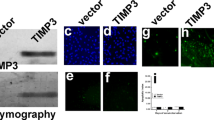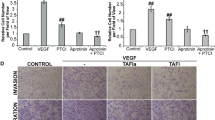Abstract
Recently two metalloproteinase, disintegrin, cysteine proteins (MDCs), also called ADAMs were identified on endothelial cells. However the role of these ADAMs are not defined on these cells. In order to elucidate whether ADAMs associated with endothelial cells could be involved in angiogenesis, we have tested the effect of an inhibitor of ADAM (GL 129471) in models of angiogenesis in vitro. Our results showed that GL 129471 inhibited endothelial cell migration and adhesion and increased the number of cells in the G2/M phase leading to an inhibition of cell proliferation. The effects of GL 129471 are not mimicked by the endogenous matrix metalloproteinase inhibitor TIMP-2. These data suggest that ADAMs may play important role in angiogenesis and could provide a new target for inhibition of angiogenesis in cancers.
Similar content being viewed by others
References
Weskamp G, Blobel CP. A family of cellular proteins related to snake venom disintegrins. Proc Natl Acad Sci USA1994; 91, 2748–2751.
Wolfsberg TG, Straight PD, Gerena R, et al.ADAM, a novel family of membrane proteins containing a disintegrin and metalloprotease domain: multipotential functions in cell-cell and cell-matrix interactions. J Cell Biol1995; 131, 275–278.
Jia LG, Shimokawa KI, Bjarnason JB, Fox JW. Snake venom metalloproteinases: structure, function and relationship to the ADAMs family of proteins. Toxicon1996; 34, 1269–1276.
Huovila AJ, Almeida EAC, White JM. ADAMs and cell fusion. Curr Opin Cell Biol1996; 8, 692–699.
Moss ML, Jin SL, Milla ME, et al.Cloning of a disintegrin metalloproteinase that processes precursor tumour necrosis factor-α. Nature1997; 385, 733–736.
Black RA, Rauch CP, Kozlosky CJ, et al.A metalloproteinase disintegrin that releases tumor necrosis factor-α from cells. Nature1997; 385, 729–733.
Blobel CP. Metalloprotease-disintegrins: links to cell adhesion and cleavage of TNFα and Notch. Cell1997; 90, 589–592.
Herren B, Raines EW, Ross R. Expression of a disintegrin like protein in culture human vascular cells and in vivo. FASEB J.1997; 11, 173–180.
Murphy GJP, Murphy G, Reynolds JJ. A unique signature identifies a family of zinc-dependent metallopeptidases. FEBS Lett1991; 289, 4–7.
Blobel CP, White JM. Structure, function and evolutionary relationship of proteins containing a disintegrin domain. Curr Opin Cell Biol1992; 4, 760–765.
Kennelly PJ, Krebs EG. Consensus sequences as substrate specificity determinants for protein kinases and protein phosphorylases. J Biol Chem1991; 266, 15555–15558.
McGeehan G, Becherer D, Bast RC, et al.Regulation of tumour necrosis factor-α processing by a metalloproteinase inhibitor. Nature1994; 370, 558–561.
Xu YL, Swerlick RA, Sepp N, et al.Characterization of expression and modulation of cell adhesion molecules on an immortalized human dermal microvascular endothelial cell line (HMEC-1). J Invest Dermatol1994; 102, 833–837.
Trochon V, Mabilat C, Bertrand P, et al.Evidence of involvement of CD44 in endothelial cell proliferation, migration and angiogenesis in vitro. Int J Cancer1996; 66, 664–668.
Nehls V, Herrmann R. The configuration of fibrin clots determines capillary morphogenesis and endothelial cell migration. Micovasc Res1995; 50, 311–322.
Koopman G, Reutelingsperger CPM, Kuijiten GAM, et al.Annexin V for flow cytometric detection and phosphatidylserine expression on B cells undergoing apoptosis. Blood1994; 84, 1415–1420.
Gallea-Robache S, Morand V, Millet S, et al.A metalloproteinase inhibitor blocks the shedding of soluble cytokine receptors and processing of transmembrane cytokine precursors in human monocytic cells. Cytokine1997; 9, 340–346.
Johnson MD, Choi Kim HR, Chesler L, et al.Inhibition of angiogenesis by tissue inhibitor of metalloproteinase. J Cell Physiol1994; 160, 194–202.
Dvorak HF, Harvey VS, Estrella P, et al.Fibrin containing gels induced angiogenesis. Implication for tumor stroma generation and wound healing. Lab Invest1987; 57, 673–686.
Author information
Authors and Affiliations
Rights and permissions
About this article
Cite this article
Trochon, V., Li, H., Vasse, M. et al. Endothelial metalloprotease-disintegrin protein (ADAM) is implicated in angiogenesis in vitro. Angiogenesis 2, 277–285 (1998). https://doi.org/10.1023/A:1009206817829
Issue Date:
DOI: https://doi.org/10.1023/A:1009206817829




